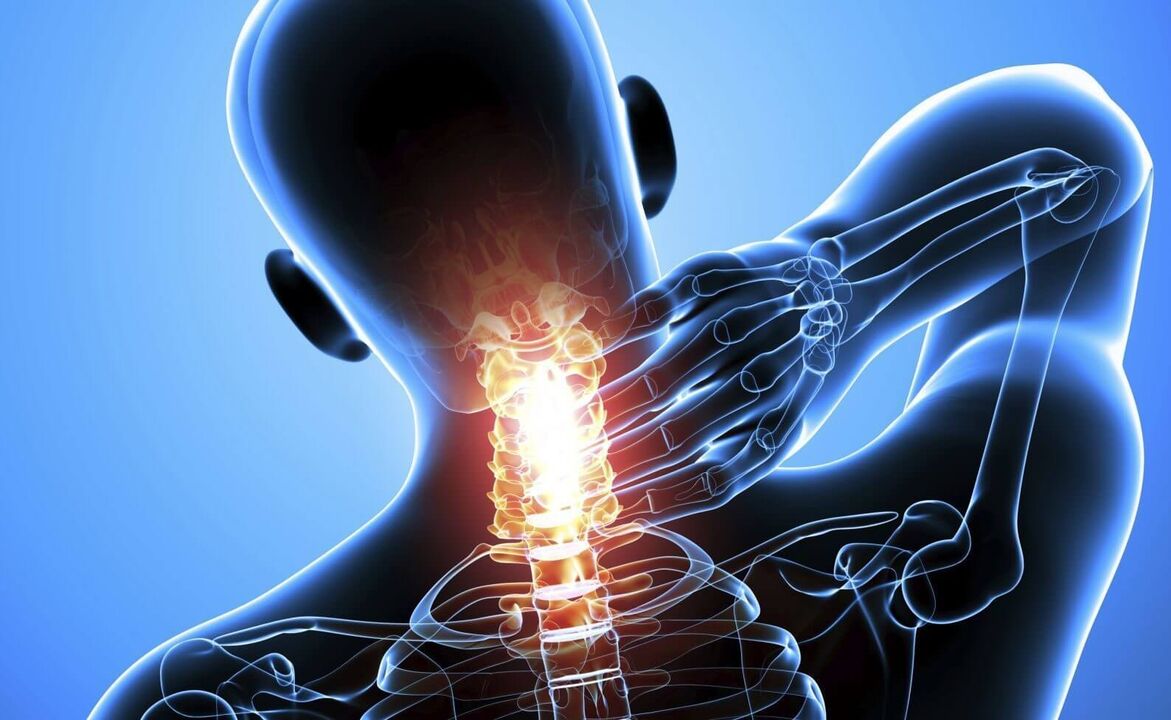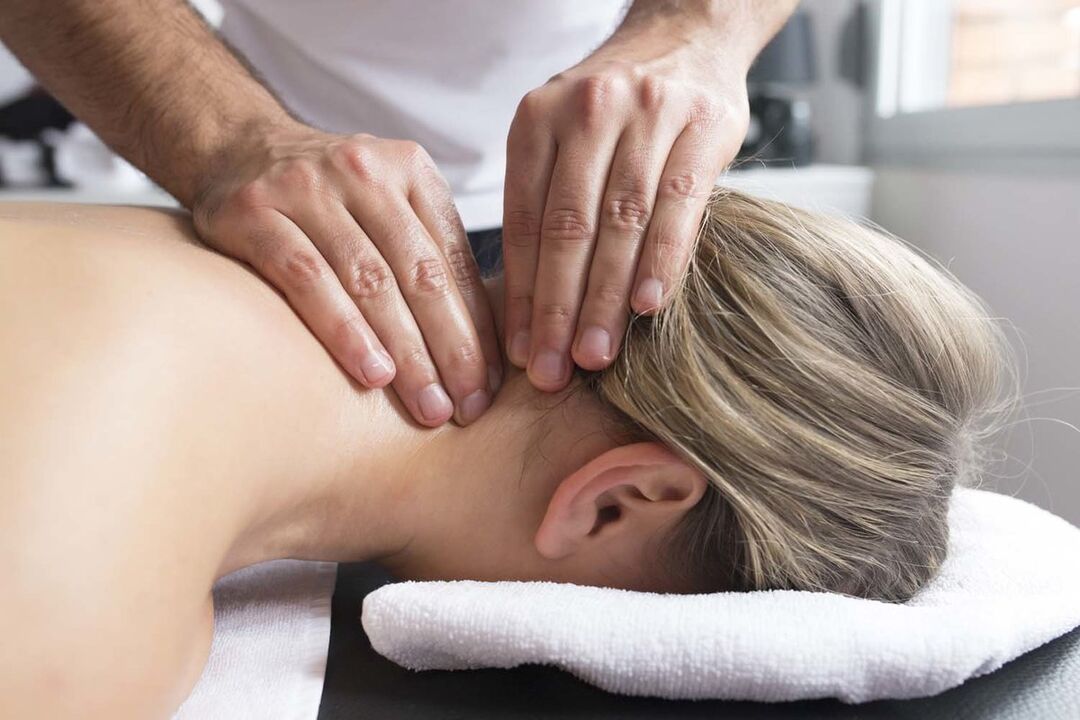
Many people experience osteochondrosis of the cervical spine.This disease develops and develops gradually and imperceptibly, but at the perfect moment, it worsens in general well-being and headaches.Is it possible to treat cervical osteochondrosis at home and which specialist should you contact for help?
How does osteochondrosis look and manifest itself?
The human cervical spine consists of seven vertebrae.They are connected to the centrally located nucleus pulposus by discs called intervertebral discs.Constantly in uncomfortable positions, creating an irrational load on the back with poor circulation and frequent muscle spasms, frequent muscle spasms, cause degenerative changes in the intervertebral cartilage of the cervical spine.The result of these changes is the appearance of cracks in the cartilage of the discs, in which the nucleus pulposus is displaced under load in the spine.This displacement causes compression of nearby structures - spinal cord and spinal nerve roots, resulting in pain.
Anyone who is careful about their health can detect the first signs of the development of osteochondrosis.Osteochondrosis of the cervical spine most often causes pain in the shoulder girdle behind the head and neck.In addition, osteochondrosis causes disruption of cerebral circulation, headache, dizziness and even loss of consciousness.
Most often, this disease occurs in people who lead a sedentary lifestyle or have a sedentary job, where the position of the head and neck is limited to a monotonous range during the working day.If a person does not receive treatment in time and tries to overcome the disease at home on his own, it worsens the situation - the distance between the vertebrae narrows, causing permanent partial or loss of work ability between bone growths.
If the above symptoms appear, you should seek help from a doctor.A vertebroad treats various pathologies of the spine;However, you can find a specialist of this profile only in large medical centers.In a regular clinic, patients with osteochondrosis are treated by a neurologist and, in his absence, by a therapist.After the examination, only a doctor can adjust or cancel the treatment (drug, folk, combined).
Stages and diagnosis of cervical osteochondrosis
The clinical course of osteochondrosis is characterized by three main stages of development, which differ in symptoms and disorders:
- Stage 1- There are already cracks in the intervertebral disc ring;Under load, it can move to the main side.At this stage, symptoms such as acute pains and spasms of the neck muscles, tongue syndrome, emergence of walking syndrome, Naffziger syndrome (brachial plexus and lower roots of the lower roots), pain in the neck muscles;
- Stage 2- The distance between the vertebrae decreases, the fibrous ring dries up, and as a result, inflammation occurs due to the rupture of the capsule.Also, the edges of the vertebral bodies grew with osteophytes - special bone growths.The symptoms of the first stage, "falling head" syndrome, "falling head" syndrome, which forces the patient to support his head with his hand, are added;
- Stage 3- At this stage, a complete rupture of the cartilage and prolapse of the nucleus pulposus and the formation of an intervertebral hernia are observed.At this stage, symptoms such as periodic pain in the neck, headache and dizziness are observed, loss of consciousness, a sharp turn of the head and "stop listening" from time to time.
To make a diagnosis, after the initial examination, you should seek help from a neurologist who will prescribe a deep examination.This should include radiography, cervical and thoracic spine, angiography and vascular ultrasound.The diagnosis of "Osteochondrosis" is carried out only on the basis of radiographs and MRI data with the presence of changes in the structure of the vertebrae and discs.
How is the treatment done?

How to treat osteochondrosis of the cervical spine?Unfortunately, there is currently no treatment that can completely get rid of this disease.The patient's condition is satisfactory and there is no need to be hospitalized, that is, he can receive treatment at home, the doctor prescribes outpatient treatment, where the patient visits the doctor and procedures on the appointed days.In severe cases of the disease, you can be hospitalized.
Drug treatment of osteochondrosis of the cervical spine prescribed by a doctor usually includes orally taken drugs of the following groups:
- pain relievers.It took 1-2 weeks for a long time 3 times a day after meals;
- Folk sedatives - anawort, Valerian, St. John's Wort.They are mild sedatives and prevent exhaustion of the nervous system due to prolonged pain.Received within 1-3 weeks;
- diuretics.They help reduce swelling in the area of inflammation;
- B vitamins - normalize muscle permeability, help improve metabolic processes in nervous tissue;
- Muscle relaxants - Help relax spasmodic muscles.
- Chondroprotectors - drugs that help improve the structure of cartilage tissue and the functioning of intervertebral discs.
In addition, gels, ointments, creams and various medicinal or folk remedies, topicals with analgesic, warming and distracting effects are used.
Other treatments

In addition to drugs and folk remedies designed to alleviate the patient's condition, treatment in position is also prescribed.At the stage of exacerbation of osteochondrosis with eye pain, the physiological position of the body allows you to remove the physiological position of the spine from the spine and reduce pain.Treatment with placement is prescribed for 1-3 days.Also, in the acute stage of osteochondrosis, doctors and physical therapy specialists recommend performing special breathing exercises and exercises that relieve muscle spasms.
In the subacute stage of cervical osteochondrosis, you can independently perform head turns and smooth bends at home.When a muscle spasm occurs, massage is a very effective way to relieve pain.You can do it yourself or trust the hands of a professional.To prevent this disease, it is useful to undergo massage sessions twice a year.Thus, the following means and methods are used to treat osteochondrosis of the cervical spine:
- gymnastics;
- massage;
- hirudotherapy (treatment with medicinal leeches);
- Wear a special bow;
- Vertical cervical traction using a special device.
Diet and maintaining a healthy lifestyle play an important role in the treatment of this disease.From the diet, it is necessary to exclude drinks and food products that contribute to the agitation and spasm of the spinal muscles of a person.Prohibited drinks and foods include: tea and coffee, alcohol and hot spices, marinades and smoked foods.Fresh vegetables and fruits, grains and legumes, nuts and boiled eggs, milk and fermented milk products and low-fat fish, beef and poultry will be beneficial for cartilage and joint tissue.






















